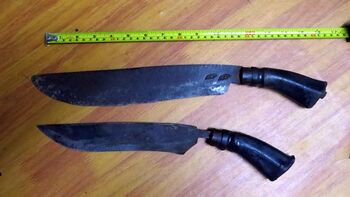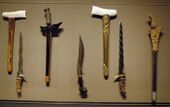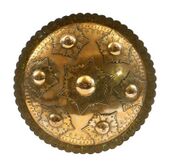Engineering:Golok Rembau
| Rembau-style golok Golok Rembau | |
|---|---|
 A pair of Malaysian style Golok Rembau. | |
| Type | Golok / Machete |
| Place of origin | Indonesia (Bengkulu, Jambi, West Sumatra)[1] |
| Service history | |
| Used by | Minangkabau people, Malay people |
| Specifications | |
| Length | approximately 35–47 cm (14–19 in) |
| Blade type | Recurve with convex edge |
| Hilt type | Water buffalo horn, wood |
| Scabbard/sheath | Wood |
Golok rembau is a type of golok in a shape of the Tumbok Lada, but in a larger version originating from Sumatra, Indonesia. It is also commonly found in Malaysia.[1]
Description
This golok has an angular hilt and a curved blade.[2] A ricasso or finger coil on the blade after the handle is a common design in most Golok Rembau. The blade has a pointy tip with a slight drop point and is approximately 23 to 40 cm (9.1 to 15.7 in) in length. The edge along the blade has a S shape curvature. While most Golok Rembau use a convex edge, some are made with somewhat hollow or flat ground on the edge near the finger coil for small whittling purposes. The scabbard is usually made of wood, however cheap leather sheath can also be found.
Culture
In Asahan Regency, Indonesia, the Golok Rembau is thought to have the magical power to protect its bearer from attack by tigers. Hence sometimes this golok is also referred to as Golok Rimau or Golok Harimau.[3] Because of this belief, men who owned or had been able to borrow the Golok Rembau, exhibited their weapons with complacency and pride.[4]
See also
References
- ↑ 1.0 1.1 Albert G Van Zonneveld (2002). Traditional Weapons of the Indonesian Archipelago. Koninklyk Instituut Voor Taal Land. ISBN 90-5450-004-2. https://www.amazon.com/Traditional-Weapons-Indonesian-Archipelago-Zonneveld/dp/9054500042/ref=sr_1_1?ie=UTF8&qid=1394869874&sr=8-1&keywords=Traditional+Weapons+of+the+Indonesian+Archipelago.
- ↑ Awang Sujai Hairul & Yusoff Khan (1977). Kamus Lengkap, Volume 1. Pustaka Zaman. ISBN 967-918-077-8.
- ↑ Eugene S. McCartney & Peter Okkelberg (1932). Papers of the Michigan Academy of Science Arts and Letters Volume 16. University of Michigan Press.
- ↑ Eliakim Littell & Robert S. Littell (1906). Littell's Living Age, Volume 250. Carl Sandburg Collections.
 |




